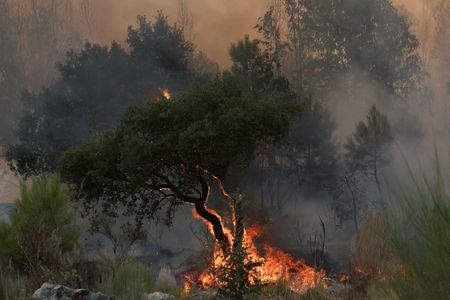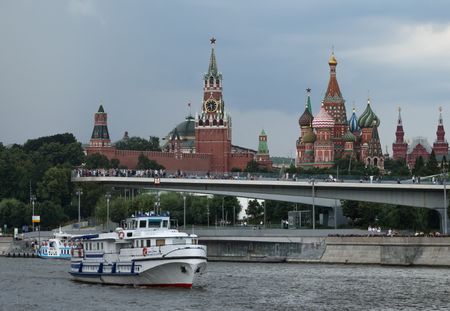By Alison Withers, Kate Abnett and Simon Johnson
COPENHAGEN/BRUSSELS/STOCKHOLM (Reuters) -Concern about the capacity of Europe’s forests, degraded by wildfires and droughts, to absorb CO2 emissions was a key reason European Union governments agreed to water down their new 2040 emissions-cutting goal this week.
EU countries on Wednesday backed a target to cut their net greenhouse gas emissions 90% by 2040 from 1990 levels – a goal designed to keep them on track for the EU’s legally-binding commitment to reach net zero emissions by 2050.
However, the accord also introduced flexibility for various sectors. One option was for future cuts to the 2040 target should Europe’s forests, peat bogs and grasslands be unable to absorb and store millions of tons of carbon dioxide to compensate for pollution from industries.
During negotiations on the 2040 goal in recent months, numerous governments – from Sweden, to Latvia, to France – warned that Europe’s forests are absorbing far less CO2 emissions than hoped, in part because of wildfires and droughts made worse by climate change.
“It is a positive achievement that the agreement takes into consideration the large uncertainties that relate to CO2 uptake from forests,” Sweden’s Environment Minister Romina Pourmokhtari said.
FORESTS FALLING SHORT OF CO2 TARGETS
Scientists have documented how climate change is leading to more heatwaves and droughts that dry out trees, slow their growth and set the stage for worse wildfires and pest infestations.
Wildfires burned more than a million hectares of EU land this year, the highest annual amount on record.
The amount of CO2 absorbed by Europe’s forests and land-use sector has dropped by nearly a third in the last decade because of climate impacts, but also due to increased logging, the European Environment Agency has said.
In Finland, forests have been emitting more carbon than they have absorbed since 2021, according to the Natural Resources Institute Finland. Sweden’s CO2 forestry sink has more than halved over the last 20 years.
Sweden and Finland both backed the EU’s 90% emissions-cutting goal and pushed back in final-hour negotiations on other countries’ attempts to weaken it further, according to EU diplomats.
However, they both warned in September they would miss EU forest emissions targets for 2030 and said they faced “dire” economic consequences if they were forced to harvest less wood to comply.
Finland’s Climate Minister Sari Multala told Reuters around 14 of the 27 EU countries are off track on their 2030 Land Use, Land-Use Change, and Forestry targets.
Forests cover around 70% of Sweden and Finland. Wood products make up around 10% of Sweden’s exports and almost a fifth for Finland. Around 140,000 people work in the sector in Sweden.
Last month, European Commission President Ursula von der Leyen promised measures to address concerns over the 2030 LULUCF laws in a letter to EU government leaders, as Brussels sought their buy-in on the 2040 climate goal.
ACCORD GIVES FLEXIBILITY ON TARGETS
The 2040 climate target, agreed after all-night negotiations between ministers in Brussels and before world leaders meet on Thursday at the U.N. COP30 Summit in Brazil, included various options to respond to these worries.
One was the introduction of an emergency brake allowing governments to reduce the 2040 climate target if it becomes clear forests and other land-based activities are off track when it comes to absorbing CO2 emissions, according to the EU deal. That option was proposed by France.
Another was allowing countries to buy foreign carbon credits to cover up to 5% of the 90% emissions-cutting goal, potentially shaving 5% off the overall domestic target.
Industries from car manufacturing to the defence sector have been concerned that they may be on the hook to make up any shortfall if forests and wetlands play a weakened role in mitigating emissions.
The final target specified that if natural ecosystems underperform, other industries will not be forced to cut emissions faster to deliver the 2040 goal.
POLITICAL CHALLENGES AHEAD
The EU’s Joint Research Centre has said climate risks to forests can be managed by reducing intense logging, or planting more diverse tree species, which may enhance CO2 storage.
Sweden’s Forestry Agency has said that reducing felling by 10% and allowing trees to grow longer were the most effective measures to increase the CO2 uptake from Sweden’s forests.
Sweden’s Environmental Objectives Committee, a government body, has similarly recommended reducing felling and incentivising forestry firms to let trees grow longer.
But doing so could be politically challenging for governments, given the forestry industry’s economic output and thousands of jobs.
The Swedish Forest Industries Federation said the government committee’s proposals would lead to a 5% to 6% fall in production of wood products, with a value of 8 billion Swedish crowns ($849.66 million) and could cost 7,200 jobs.
($1 = 9.4155 Swedish crowns)
(Reporting by Alison Withers, Kate Abnett and Simon Johnson; Editing by Sharon Singleton)










